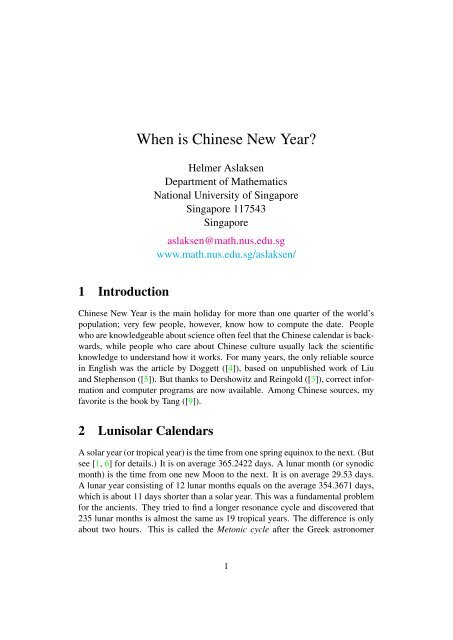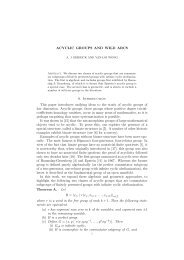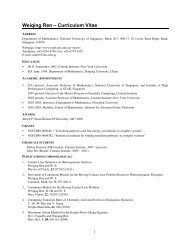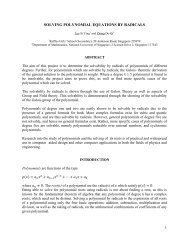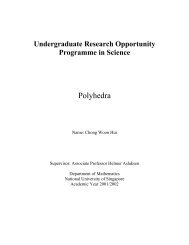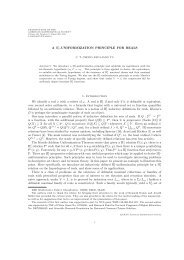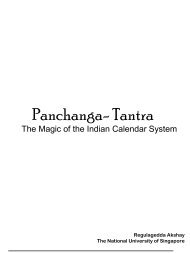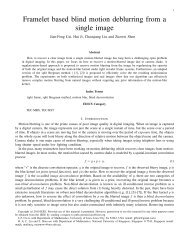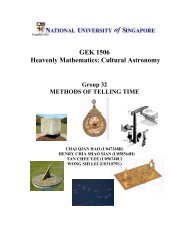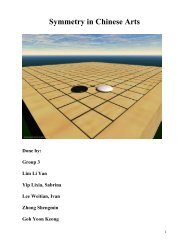When is Chinese New Year? - Department of Mathematics
When is Chinese New Year? - Department of Mathematics
When is Chinese New Year? - Department of Mathematics
Create successful ePaper yourself
Turn your PDF publications into a flip-book with our unique Google optimized e-Paper software.
1 Introduction<br />
<strong>When</strong> <strong>is</strong> <strong>Chinese</strong> <strong>New</strong> <strong>Year</strong>?<br />
Helmer Aslaksen<br />
<strong>Department</strong> <strong>of</strong> <strong>Mathematics</strong><br />
National University <strong>of</strong> Singapore<br />
Singapore 117543<br />
Singapore<br />
aslaksen@math.nus.edu.sg<br />
www.math.nus.edu.sg/aslaksen/<br />
<strong>Chinese</strong> <strong>New</strong> <strong>Year</strong> <strong>is</strong> the main holiday for more than one quarter <strong>of</strong> the world’s<br />
population; very few people, however, know how to compute the date. People<br />
who are knowledgeable about science <strong>of</strong>ten feel that the <strong>Chinese</strong> calendar <strong>is</strong> backwards,<br />
while people who care about <strong>Chinese</strong> culture usually lack the scientific<br />
knowledge to understand how it works. For many years, the only reliable source<br />
in Engl<strong>is</strong>h was the article by Doggett ([4]), based on unpubl<strong>is</strong>hed work <strong>of</strong> Liu<br />
and Stephenson ([5]). But thanks to Dershowitz and Reingold ([3]), correct information<br />
and computer programs are now available. Among <strong>Chinese</strong> sources, my<br />
favorite <strong>is</strong> the book by Tang ([9]).<br />
2 Lun<strong>is</strong>olar Calendars<br />
A solar year (or tropical year) <strong>is</strong> the time from one spring equinox to the next. (But<br />
see [1, 6] for details.) It <strong>is</strong> on average 365.2422 days. A lunar month (or synodic<br />
month) <strong>is</strong> the time from one new Moon to the next. It <strong>is</strong> on average 29.53 days.<br />
A lunar year cons<strong>is</strong>ting <strong>of</strong> 12 lunar months equals on the average 354.3671 days,<br />
which <strong>is</strong> about 11 days shorter than a solar year. Th<strong>is</strong> was a fundamental problem<br />
for the ancients. They tried to find a longer resonance cycle and d<strong>is</strong>covered that<br />
235 lunar months <strong>is</strong> almost the same as 19 tropical years. The difference <strong>is</strong> only<br />
about two hours. Th<strong>is</strong> <strong>is</strong> called the Metonic cycle after the Greek astronomer<br />
1
Meton who used it in 432 BCE, but it was known to the Babylonians by around<br />
500 BCE and to the <strong>Chinese</strong> around 600 BCE ([2]).<br />
A lunar calendar ignores the Sun and the seasons but follows the Moon. The<br />
main example <strong>is</strong> the Muslim calendar. Since 12 lunar months <strong>is</strong> about 11 days<br />
shorter than the tropical year, the Islamic holidays regress through the seasons.<br />
Lun<strong>is</strong>olar calendars use lunar months to approximate the tropical year. Examples<br />
are the Jew<strong>is</strong>h and <strong>Chinese</strong> calendars. Since 12 months are about 11 days<br />
shorter than the tropical year, a leap month (intercalary month) <strong>is</strong> inserted about<br />
every third year to keep the calendar in tune with the seasons. Notice that the<br />
<strong>Chinese</strong> calendar <strong>is</strong> not a lunar calendar! The <strong>Chinese</strong> name <strong>is</strong> yīn yáng lì (d
J1 Lì chūn d
Astronomical <strong>Chinese</strong> Western Celtic<br />
lì chūn Groundhog Day, Candlemas Imbolg<br />
March equinox chūn fēn Lady Day, Annunciation Day<br />
lì xià May Day, Walpurg<strong>is</strong>nacht Beltane<br />
June solstice xià zhì Midsummer Day<br />
lì qiū Lammas Lughnasa<br />
September equinox qiū fēn Michaelmas<br />
lì dōng Halloween, All Saints’, Guy<br />
Fawkes, Martinmas<br />
Samhain<br />
December solstice dōng zhì Chr<strong>is</strong>tmas Day<br />
Table 2: Holidays related to seasonal markers<br />
Th<strong>is</strong> <strong>is</strong> similar to the ecclesiastical calendar, where Chr<strong>is</strong>tmas Day and Annunciation<br />
Day on March 25 are solar holidays, while all the other holidays are tied to<br />
Easter and are therefore lunar.<br />
4 The Rules <strong>of</strong> the <strong>Chinese</strong> Calendar<br />
We can now state the rules for the modern <strong>Chinese</strong> calendar.<br />
Rule 1 Calculations are based on the meridian 120 ı East.<br />
Before 1929 the computations were based on the meridian in Beijing (116 ı 25 0 ),<br />
but in 1928 China adopted a standard time zone based on 120 ı East. Since 1949<br />
the Purple Mountain Observatory in Nanjing has been responsible for calendrical<br />
calculations in China.<br />
Rule 2 The day on which the new Moon occurs <strong>is</strong> the first day <strong>of</strong> the month.<br />
The length <strong>of</strong> the months are determined astronomically (Table 3). Suppose a<br />
lunar month <strong>is</strong> 29.5 days, and starts with a new Moon at 13h on May 1. The next<br />
new Moon then takes place at 1h on May 31, so the month has 30 days. But if the<br />
new Moon occurred at 1h on May 1, then the next new Moon would be at 13h on<br />
May 30, so the new month would start one day earlier, and we would only get 29<br />
days in the month.<br />
In the Gregorian calendar all the months (except for February) have the same<br />
number <strong>of</strong> days in different years. Th<strong>is</strong> <strong>is</strong> not the case for the <strong>Chinese</strong> calendar.<br />
A month may have 29 or 30 days in different years. Since the mean lunar month<br />
<strong>is</strong> 29.53 days, a little over half the months are big months, dà yuè (d
<strong>New</strong> Moon Next new Moon Length<br />
May 1 13h May 31 1h 30 days<br />
May 1 1h May 30 13h 29 days<br />
Table 3: Determining the length <strong>of</strong> the months<br />
days and a little under half the months are small months, xiǎo yuè (d
There are therefore two different years in the <strong>Chinese</strong> calendar, the suì (d
If there <strong>is</strong> a new Moon on the day after the December solstice or within about<br />
11 days, the suì <strong>is</strong> a leap suì. If there <strong>is</strong> a new Moon on the same day as the<br />
December solstice or the first new Moon after the December solstice <strong>is</strong> more than<br />
about 12 days later, it <strong>is</strong> a normal year. Notice that the leap year test applies to<br />
suì’s and not to nián’s.<br />
Because <strong>of</strong> Kepler’s Second Law, the speed <strong>of</strong> the (apparent) motion <strong>of</strong> the<br />
Sun across the ecliptic <strong>is</strong> not constant, so the time between the zhōng qì’s <strong>is</strong> not<br />
constant. Th<strong>is</strong> was known to <strong>Chinese</strong> astronomers since the 7th century, but it was<br />
not until the last calendar reform in 1645 that they started using the true Sun, dìng<br />
qì (d
Notice that any month can have a leap month. Some <strong>Chinese</strong> astronomers<br />
claim that there can be no leap month after the 11th, 12th or 1st month. Th<strong>is</strong> <strong>is</strong><br />
true in the sense that it hasn’t happened since the last calendar reform in 1645.<br />
But because <strong>of</strong> the precession <strong>of</strong> the equinoxes ([1]) it <strong>is</strong> clear that in the future<br />
there will be many such leap months. In 2033 there will be a leap month after the<br />
11th month. Th<strong>is</strong> was an error in <strong>Chinese</strong> calendar until about 1990 ([1, 5]). I<br />
believe that in 2262 there will be a leap month after the 1st month, and in 3358 a<br />
leap month after the 12th ([1]).<br />
I would also like to mention that some astrological sources use a year running<br />
from lì chūn to lì chūn, and claim that your <strong>Chinese</strong> zodiac animal should be<br />
based on th<strong>is</strong>. In 1960, <strong>Chinese</strong> <strong>New</strong> <strong>Year</strong> fell on January 28 while lì chūn fell on<br />
February 5. If you were born on February 1, you would not be a rat, but a pig!<br />
6 What <strong>is</strong> the Date <strong>of</strong> <strong>Chinese</strong> <strong>New</strong> <strong>Year</strong>?<br />
The exact date <strong>of</strong> <strong>Chinese</strong> <strong>New</strong> <strong>Year</strong> follows from the above rules. Table 7 shows<br />
that the possible dates <strong>of</strong> <strong>Chinese</strong> <strong>New</strong> <strong>Year</strong> between 1645 and 2644 are between<br />
January 21 and February 21.<br />
38<br />
28 32 32353236<br />
39<br />
31<br />
35 38 42<br />
37<br />
30 2931<br />
30 30 33 33<br />
38<br />
42<br />
30343536<br />
31<br />
25<br />
29<br />
18<br />
10<br />
1<br />
2122232425262728293031<br />
1 2 3 4 5 6 7 8 9 101112131415161718192021<br />
Table 7: Dates <strong>of</strong> <strong>Chinese</strong> <strong>New</strong> <strong>Year</strong> between 1645 and 2644<br />
<strong>Chinese</strong> <strong>New</strong> <strong>Year</strong> moves backwards by 11 days (or 10 or 12) once or twice,<br />
but if a step would take it before (or in some cases, close to) January 21, it jumps<br />
forward by 19 (or 18 or 20) days as in Table 8. There are also two simple rules <strong>of</strong><br />
thumb.<br />
1997 1998 1999 2000 2001 2002 2003 2004 2005 2006 2007<br />
7/2 28/1 16/2 5/2 24/1 12/2 1/2 22/1 9/2 29/1 18/2<br />
-10 +19 -11 -12 +19 -11 -10 +18 -11 +20<br />
Table 8: The movement <strong>of</strong> the dates <strong>of</strong> <strong>Chinese</strong> <strong>New</strong> <strong>Year</strong><br />
Rule <strong>of</strong> thumb 1 <strong>Chinese</strong> <strong>New</strong> <strong>Year</strong> falls on the day <strong>of</strong> the second new Moon<br />
after the December solstice.<br />
8
Since the December solstice falls in the 11th month, th<strong>is</strong> rule <strong>of</strong> thumb <strong>is</strong><br />
correct provided there <strong>is</strong> no leap month after the 11th or 12th month. In that case,<br />
<strong>Chinese</strong> <strong>New</strong> <strong>Year</strong> falls on the third new Moon after the December solstice. It<br />
can be shown ([1]) that there can only be a leap month between the December<br />
solstice and <strong>Chinese</strong> <strong>New</strong> <strong>Year</strong> if there <strong>is</strong> a new Moon very soon after (but not<br />
on the same day as) the December solstice, so the second new Moon will then be<br />
around January 21 and the third around February 21.<br />
Rule <strong>of</strong> thumb 2 <strong>Chinese</strong> <strong>New</strong> <strong>Year</strong> falls on the day <strong>of</strong> the new Moon closest to<br />
lì chūn (d
<strong>When</strong> they made an error <strong>of</strong> more than half an hour in computing a solar eclipse<br />
on December 15, 1610, it caused serious embarrassment. Finally, in 1629 Xǔ<br />
Guāng Qǐ (d
un by other Westerners until 1826.<br />
References<br />
[1] Helmer ASLAKSEN, The <strong>Mathematics</strong> <strong>of</strong> the <strong>Chinese</strong> Calendar, preprint,<br />
National Univ. <strong>of</strong> Singapore, http://www.math.nus.edu.sg/<br />
aslaksen/calendar/, 1999.<br />
[2] CHEN Cheng-Yih, Early <strong>Chinese</strong> Work in Natural Science, Hong Kong University<br />
Press, 1996.<br />
[3] Nachum DERSHOWITZ and Edward M. REINGOLD, Calendrical Calculations,<br />
Cambridge University Press, 1997.<br />
[4] L. E. DOGGETT, Calendars, in “Explanatory Supplement to the Astronomical<br />
Almanac”, P. Kenneth Seidelmann (ed.), University Science Books,<br />
1992, 575–608.<br />
[5] LIU Baolin and F. Richard STEPHENSON, The <strong>Chinese</strong> Calendar and its<br />
Operational Rules, manuscript.<br />
[6] Jean MEEUS and Den<strong>is</strong> SAVOIE, The H<strong>is</strong>tory <strong>of</strong> the Tropical <strong>Year</strong>, Journal<br />
<strong>of</strong> the Brit<strong>is</strong>h Astronomical Association 102 (1992), 40–42.<br />
[7] Donald W. OLSON, Richard Tresch FIENBERG, Roger W. SINNOTT,<br />
What’s a Blue Moon?, Sky & Telescope, 97 No. 5 (May 1999), 36–38.<br />
[8] Jonathan SPENCE, To Change China, Western Adv<strong>is</strong>ors in China 1620–<br />
1960, Little, Brown, 1969.<br />
[9] TANG Hanliang (d


